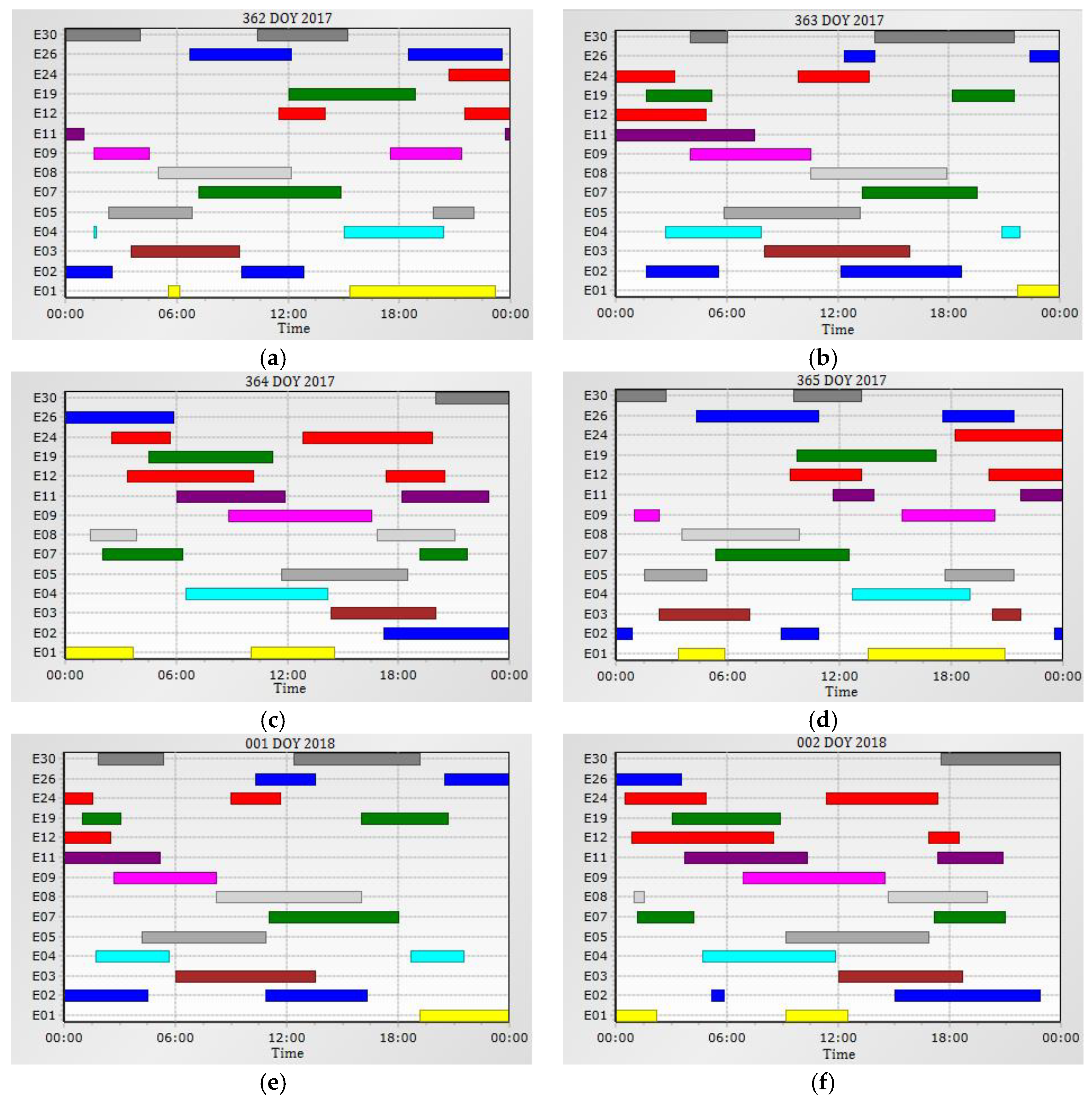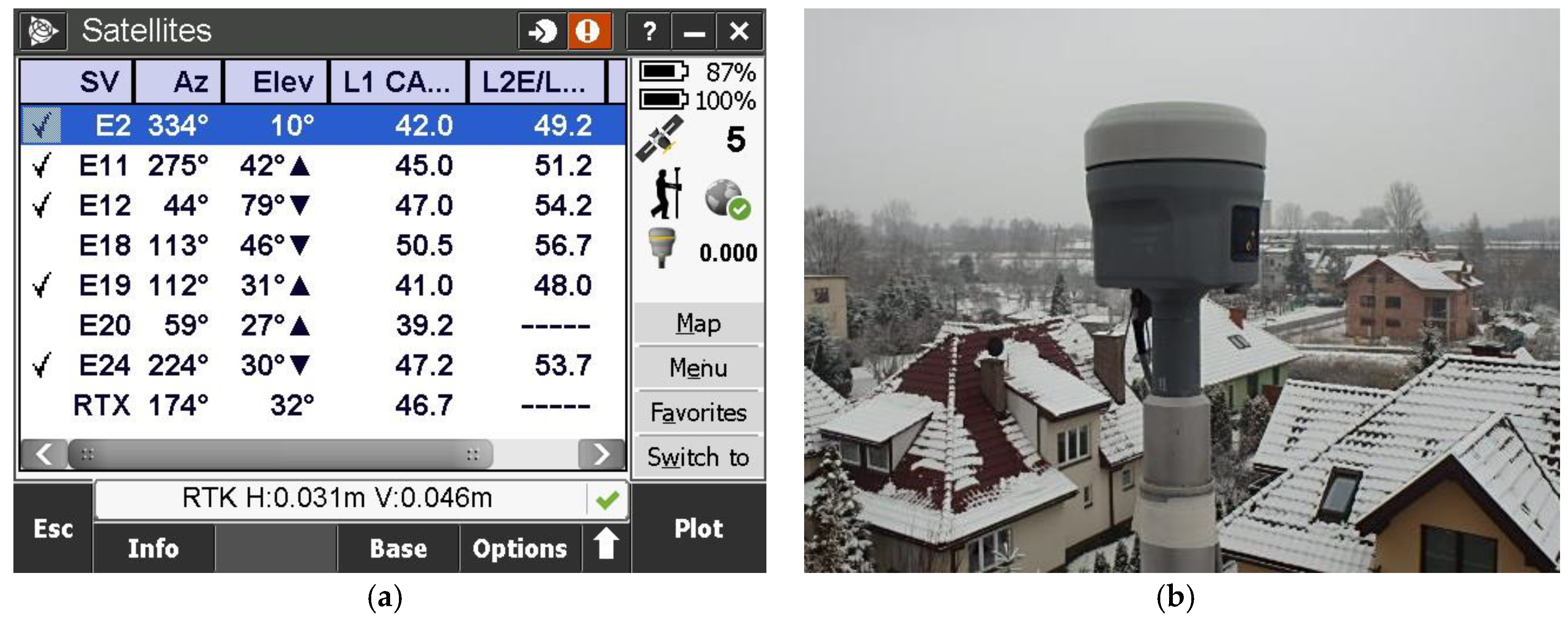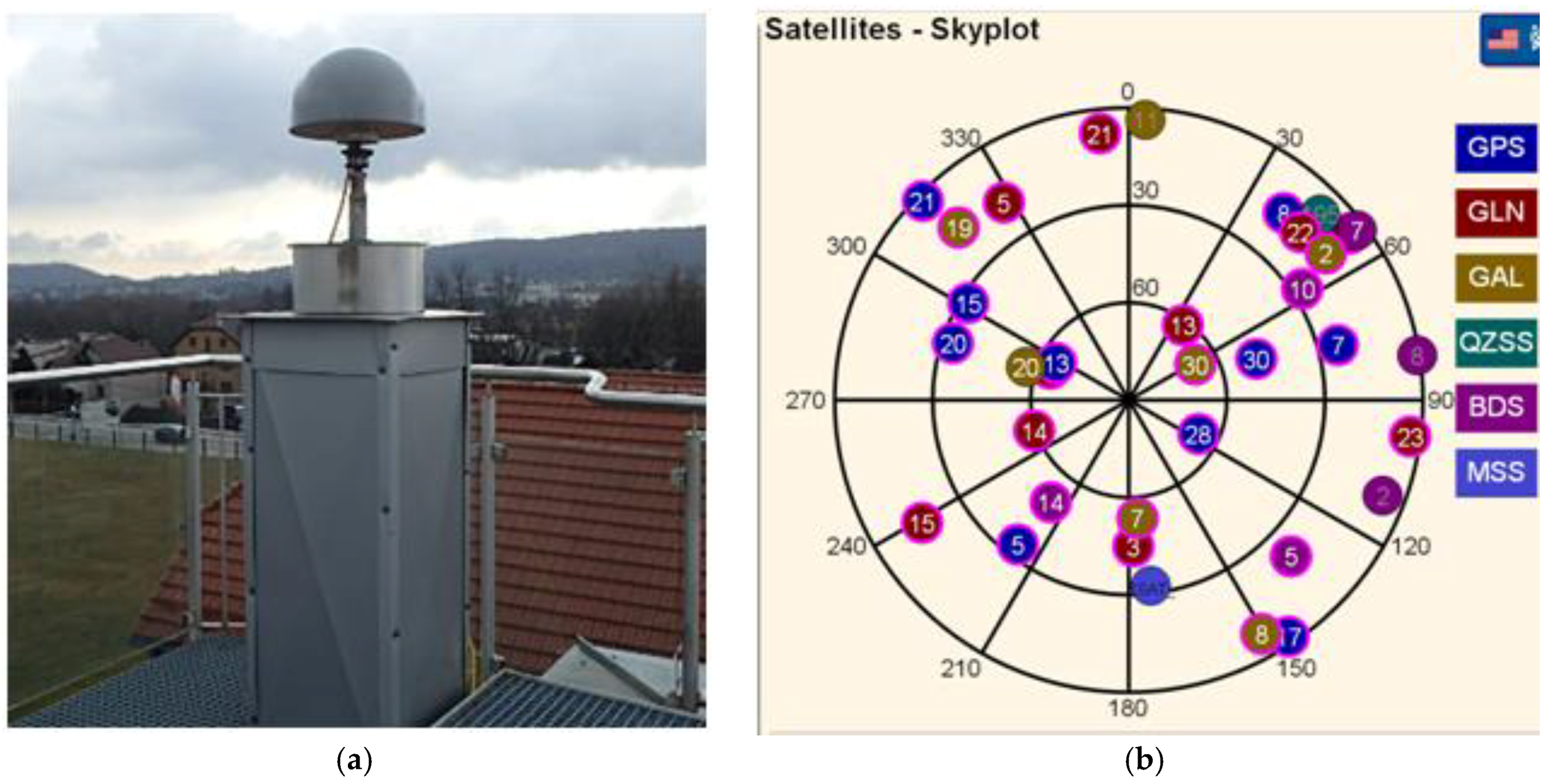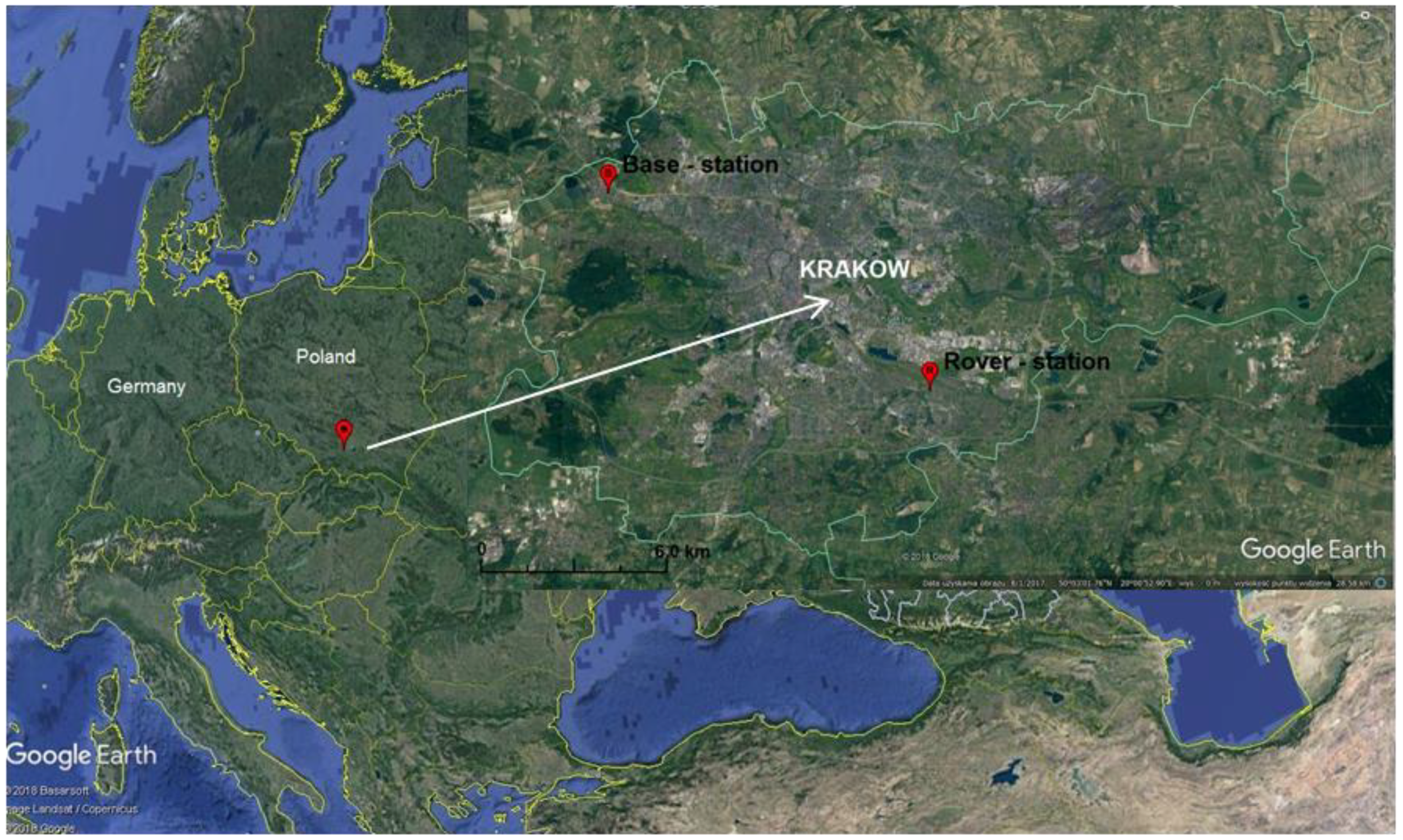2.1. Assessment of Availability and Continuity of Positioning Based on the Constellation of Galileo Satellites
The constellation of the Galileo satellites is not yet complete, and FOC is expected in 2020. For this reason, RTK test measurements were therefore only possible to be made in specific time windows within 24 h, when the number of observed satellites was at least 5 or more. In the site, Krakow-Poland (φ = 50.0207, λ = 20.0221), during time span (362–365 DOY 2017 and 001–002 DOY 2018) it was possible to observe simultaneously from one to seven satellites on the elevation above 10° (
Figure 1). Current (December 2017) the constellation of Galileo satellites, consists of 18 satellites, including 14 fully operational ones. Four satellites of the Galileo constellation are indicated as unusable “Unh–Unhealthy)” for various reasons. Two satellites: E14, Galileo 5 (Galileo-FOC FM1, GSAT 0201, Doresa) and E18, Galileo 6 (Galileo-FOC2, GSAT 0202, Milena) launched in August 2014, due to the failure of the Russian Soyuz-ST-B Fregat-MT carrier rocket, were placed on an elliptical orbit with too high eccentricity. Therefore, they cannot be used for navigation purposes nor positioning. Moreover, the satellite E20, Galileo-IOV FM4 (GSAT0104, Sif), broadcast only 1 frequency (E1-1575.42 MHz) due to power failure which occured on 27 May 2016. It also does not send a navigational message, therefore it can not be used in precise real-time positioning (GPS World-August 2017). The satellite E22, Galileo 8 (Galileo-FOC FM4, GSAT 0204, Anastasia), from 08 December 2017 is not available. It was removed until cancellation from the active constellation, due to problems with the on-board clock.
The orbits of Galileo operational satellites are located at an altitude of approximately 23.222 thousand km above the equator, which means that, on average, Galileo satellites have higher orbits by more than 3000 km relative to GPS satellites. The angle of inclination of the planes of Galileo satellites relative to the equator plane is greater by approximately 1° compared to the satellites of the GPS constellation. The eccentricities of the orbits of the Galileo satellites are in the range of E07 = 0.000080 to E24 = 0.000358.
Table 1,
Table 2,
Table 3,
Table 4,
Table 5 and
Table 6 contain the following data: identified time intervals, the number of available Galileo satellites and visibility times of individual satellite constellations in the considered period, i.e., from 28 December 2017 to 2 January 2018. In addition, a detailed list of satellites is provided for time intervals in which at least five satellites were available above 10° horizontal angle. The performed research shows that 62 time intervals were recorded with a duration from 10 min to 1 h 50 min with sufficient number of satellites for RTK measurements (5–7).
The research carried out (
Table 7) showed that the constellation of Galileo satellites allowed measurements for 18.75–49.31% in the following observation days.
The problem of discontinuity in observations occurs for kinematic and static measurements. It appears when a new satellite constellation is being built until the full operational capability is completed. Discontinuities in observations also occur when using fully operational systems such as GPS and GLONASS but measurements are made under difficult observational conditions for example, in wooded areas or places where there are other obstacles limiting access to satellites. Such situations occur usually in the case of rapid static measurements [
12] or measurements in urban canyons [
13]. The discontinuity problem occur also in the case of Precise Point Positioning (PPP) using different GNSS [
14]. The references considering discontinuities in satellite observations proposed by the reviewer were added as a source of additional valuable information.
2.2. Study of the GNSS Receiver Convergence Time for a Specified Accuracy of the RTK Solution
The study involved the determination of the convergence time of the Trimble R10 receiver, in RTK measurements, for a single baseline <14 km, for the accuracy of horizontal and vertical measurements ≤0.05 m using only Galileo satellites [
15]. The convergence time included the RTK measurement initialization time, which was counted from the moment the mobile receiver “rover” was connected to the assistance system (correction from KRUR—single reference station) until the assumed accuracy of the solution was achieved (≤0.05 m). Convergence time varies depending on the state of Galileo constellation, the level of multithreading, the proximity of obstacles such as high trees and buildings, and the calculation algorithms used by the receiver. The software used for experimental measurements of the Trimble R10 receiver, includes the new processing algorithm—Trimble HD-GNSS. It can use all GNSS constellations and implements a new approach in determination of the phase uncertainty. The applied solution determines the total number of phase cycles in a continuous manner based on data from subsequent measurement epochs [
16]. It omits the traditional, two-stage method of initiating RTK measurements with taking into account the transition from the “float” solution to the “fixed” one.
Table 8 summarizes the detailed results of the obtained convergence times. During the tests, they ranged from 10 s to 10 min and 10 s. The shortest convergence times ≤10 s occurred in 14 cases, with the most advantageous satellites positions at the observation site, when PDOP (Position Dilution of Precision) ˂3.0. The initialization time from the interval (20 s–59 s) occurred in 5 cases when the PDOP values were within the range (3.26–4.81). Convergence times (1 min 20 s–4 min 00 s) occurred in 5 cases when the PDOP values were within the range (3.04–6.01). The longest convergence times in the interval (5 min 20 s–10 min 10 s) occurred in the remaining 6 cases when the PDOP values were within the range (2.82–6.21). In general, it can be concluded that the initial value of the PDOP parameter determines the duration of the convergence strict (in the case under study accuracy ≤0.05 m was arbitrarily assumed). However, this is not a strict rule. As can be seen from
Table 8, in some cases lower values (theoretically more favorable) of the PDOP yielded longer initialization times. This confirms the well-known principle that the PDOP is only one of several parameters which is correlated with the duration of the initialization time. The results obtained indicate that it is also important which satellites are observed at a given moment. Each navigation satellite is characterized by its unique observational parameters, which in general can be described as non-system equipment noise of satellites. Unfortunately Trimble R10 GNSS receiver software (Trimble Access TM), used to manage measurements in real time, does not allow to obtain detailed information about satellites participating in a given solution. However, there is no information about the names of satellites. Therefore, a detailed analysis of the data in this respect is hindered.
2.3. Accuracy of Geodetic, Precise Positioning with the Use of RTK Method Based on Observations of Galileo Satellites
The main purpose of this work is to present real capabilities and performance of precise, geodetic GNSS real time measurements, using signals from Galileo satellites only and corrections from ground reference stations. The constellation of 14 fully operational Galileo satellites now enables RTK (Real Time Kinematic) measurements. However, it is possible only in certain time spans during a day and in specific areas of the globe. These capabilities were used to analyze the availability of Galileo satellites, first in general for the territory of Poland, and then for the selected site (Kraków φ = 50.0207, λ = 20.0221). Measurements were made within six days to cover a sufficiently long period of time and thus give reliable results. The period 362–365 DOY 2017 (GPS WEEK 1981) and 001–002 DOY 2018 (GPS WEEK 1982) was selected. On the basis of detailed assessments of availability and continuity of positioning carried out for the Galileo system (
Table 1,
Table 2,
Table 3,
Table 4,
Table 5,
Table 6 and
Table 7) and pre-identified 62 time intervals in which five or more satellites were available, 36 time windows were selected with a duration of 30 min to 1 h.
In the measurements the Trimble R10 company kit with the TSC3 controller were used (
Figure 2). The Trimble R10, is a new generation, 440 channel integrated with the R10 Internal antenna, multi-system satellite receiver. It can simultaneously track up to 18 observation codes. It is adapted for tracking all currently available positioning and navigation systems: GPS (L1-C/A, L2E, L2C, L5), GLONASS (L1-C/A, L1P, L2C/A, L3), Galileo (E1, E5-A, E5-B, E5AltBOC), BeiDou (B1, B2), QZSS (L1-C/A, L1-SAIF, L1C, L2C, L5), SBAS (L1-C/A, L5), MSS (Service: RTX/xFill) (Trimble AccessTM software 2015). RTK corrections were provided by the KRUR scientific reference station, (
Figure 3) working permanently since 1 November 2009 at the University of Agriculture in Krakow. The GNSS receiving antenna is located on a special observation pillar built for this purpose integrated into the building of the Faculty of Environmental Engineering and Geodesy at Balice 253C Street in Krakow. The observation pillar is independent of the entire building. Its upper part reaches about 1.5 m above the roof of the building (
Figure 3), so that the satellite antenna installed on the pillar has a fully open observation horizon.
The reference station KRUR works on the basis of the Trimble NetR9 measurement set (Serial Number: 5025K68510) and antenna GNSS Choke w/SCIS Dome (Serial Number: 5511356093) with the individual calibration. This station observes and provides differential corrections to all currently available navigation systems (
Figure 3b: GPS, GLONASS, Galileo, BeiDou QZSS). For the purpose of research carried out as a part of this work, multiple RTK measurements were made using the KRUR station as a single reference station. During experimental measurements, the KRUR station provided corrections to the observed satellites of the Galileo system via a mobile internet connection.
The KRUR reference station determines satellite corrections based on the internal Trimble NetR9 receiver software—Active Firmware Version 5.30. During 36 completed observation sessions more than 9700 of repetitive coordinate determinations at a static checkpoint were made. For each measurement, the following information was recorded in the automatic mode with an interval of 10 s, in accordance with:
- -
the name of the base point
- -
the name of the measuring point
- -
solution type
- -
date and time of measurement
- -
the height of the antenna
- -
components of vectors: ECEF: ∆X, ∆Y, ∆Z related to the base reference station
- -
the value of the PDOP parameter at which the position was determined
- -
the total number of tracked satellites, on the basis of which the position was determined
- -
detailed list of satellites of particular navigation systems (GPS, GLO, GAL, BDS) that were involved in the position determination
- -
coordinates (x-north, y-east, h-height) in the Polska/CS2000 system
- -
horizontal and vertical precision obtained when determining subsequent positions.
In the experimental measurements, the Real Time Kinematic (RTK) measurement technique was used with On-The-Fly initialization (OTF), which allows the position to be determined in the “near” real time with the centimeter accuracy. The OTF initialization consists in a quick solution of the problem of the uncertainty of phase measurements by a mobile receiver (rover) on the basis of data telemetrically transmitted from the reference station corrections to the pseudoranges and raw data for the phase measurements. The measurements used a single KRUR reference station, which carried out continuous observations and sent corrections in the CMRx format via mobile Internet to the rover receiver. The paper includes only measurement results, in which a full solution of the ambiguity of measurements by the rover receiver was obtained.
Time delays in providing correction data from reference stations to a real-time rover receiver are generally unavoidable. The size of this delay affects the accuracy of the position being determined. As demonstrated in the work [
17] in the Real-time differential positioning (RTD) simultaneous use of several GNSS systems can compensate for longer time delays of delivered corrections in relation to positioning with the use of only one positioning system (e.g., GPS or BeiDou) while maintaining the same positioning accuracy. In the present paper, it is assumed that the magnitude of this delay cannot be greater than 1 s due to the fact that the positioning used the single Galileo system.
The location of the base station relative to the rover receiver is shown in
Figure 4. The distance of the base station from the rover receiver that performed RTK measurements was approximately 13.9 km. Both the base station and the rover receiver were located in places with favorable conditions for satellite measurements. It was assumed that the reference station and the rover receiver received the same signals from the Galileo satellites (E1, E5-A, E5-B, E5-AltBOC).








